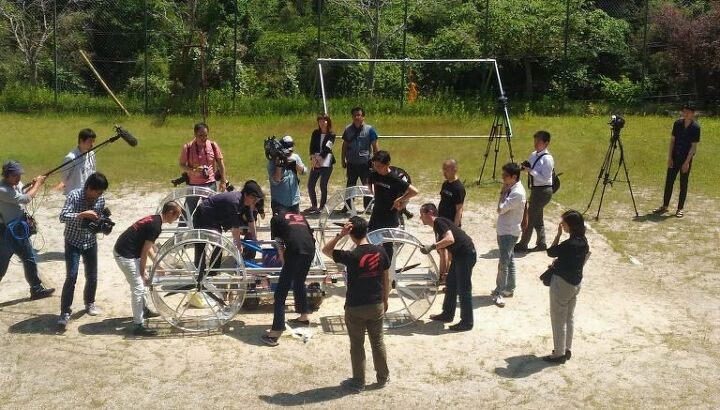Shenanigans: Toyota's 'Flying Car' Doesn't Fly and Isn't a Car

We need to have a candid discussion about flying cars. Automobiles and airplanes entered into the mainstream around the same time, and we’ve talked about combining them into a singular platform ever since. While nobody has successfully pulled it off, we keep acting like the technology is right around the corner. The closest we’ve gotten are the Terrafugia Transition and Pal-V One. However, both of those products make major on-road sacrifices, undergo a pre-flight metamorphosis, and require regular access to a runway. They’re still not representative of anything we’d consider a real car.
Lack of success hasn’t stopped automakers from dabbling in the field of aviation. Toyota has purchased Cartivator Resource Management in the hopes that its “flying car” expertise will yield a vehicle capable of lighting the torch at the 2020 Olympic games in Tokyo. Still, based on the firm’s progress to date, we can only imagine the attempt ending in a globally broadcast fiery disaster.
Cartivator’s current project essentially involves aluminum scaffolding attached to eight propellers. It’s an uncooperative and suicidal drone that manages to hover a few feet off the ground before immediately crashing to the pavement — and the company wants someone to pilot it above a flaming cauldron in just a few years.
Toyota has invested 42.5 million yen ($386,000) into the startup for work on its “Sky Drive,” and Cartivator hopes the investment will provide the means to move the project along. The team’s lead, Tsubasa Nakamura, told The Associated Press the company wants to provide a vehicle offering seamless transition between driving and flight, à la “Back to the Future.”
“I always loved planes and cars. And my longtime dream was to have a personal vehicle that can fly and go many places,” said Nakamura.
While the company looks to have an incredibly long way to go before Sky Drive goes anywhere, vertical takeoff would set it apart from literally every other “flying car” milling around in development hell. But it doesn’t currently have wheels, a roof, or a seat for the exceedingly brave pilot this giant quadcopter is supposed to cart around.
Even if it could be made safe, Cartivator’s ultimate goal for the project wouldn’t result in something you’d ever be able to call a car. Members of the Sky Drive team have suggested the vehicle should one day be capable of flight, with a maximum ceiling of around 30 feet.
Automakers, please stop calling these objects flying cars. Media outlets, please stop acting like this technology is anywhere near mainstream acceptance. What we have now are roadworthy aircraft and that’s likely all we’ll see for the foreseeable future. Regulators would never allow for deafeningly loud, open-prop vehicles capable of three-dimensional mobility and the autonomous technology needed to make them safe doesn’t exist.
Re-categorize them as mobility solutions, single-occupant flight systems, or whatever the hell else you want to call them. But please stop referring to them as “flying cars” because we’re calling shenanigans.
[Image: Cartivator Resource Management]

A staunch consumer advocate tracking industry trends and regulation. Before joining TTAC, Matt spent a decade working for marketing and research firms based in NYC. Clients included several of the world’s largest automakers, global tire brands, and aftermarket part suppliers. Dissatisfied with the corporate world and resentful of having to wear suits everyday, he pivoted to writing about cars. Since then, that man has become an ardent supporter of the right-to-repair movement, been interviewed on the auto industry by national radio broadcasts, driven more rental cars than anyone ever should, participated in amateur rallying events, and received the requisite minimum training as sanctioned by the SCCA. Handy with a wrench, Matt grew up surrounded by Detroit auto workers and managed to get a pizza delivery job before he was legally eligible. He later found himself driving box trucks through Manhattan, guaranteeing future sympathy for actual truckers. He continues to conduct research pertaining to the automotive sector as an independent contractor and has since moved back to his native Michigan, closer to where the cars are born. A contrarian, Matt claims to prefer understeer — stating that front and all-wheel drive vehicles cater best to his driving style.
More by Matt Posky
Latest Car Reviews
Read moreLatest Product Reviews
Read moreRecent Comments
- ToolGuy TG likes price reductions.
- ToolGuy I could go for a Mustang with a Subaru powertrain. (Maybe some additional ground clearance.)
- ToolGuy Does Tim Healey care about TTAC? 😉
- ToolGuy I am slashing my food budget by 1%.
- ToolGuy TG grows skeptical about his government protecting him from bad decisions.


































Comments
Join the conversation
Why does this thing not have auto-hover or some kind of stabilization software running? Model helicopters have it, drones have it...heck, I used to write this kind of real-time feedback-response hardware control code myself back in the dawn of of computing. If I could do it with a 6502 processor and 48K of RAM then anyone can do it. All engineers, no coders?
THIS is what $ 390k gets you? F**k off...